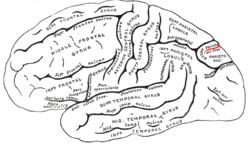Inneuroanatomy, the parieto-occipital sulcus (also called the parieto-occipital fissure) is a deep sulcus in the cerebral cortex that marks the boundary between the cuneus and precuneus, and also between the parietal and occipital lobes. Only a small part can be seen on the lateral surface of the hemisphere, its chief part being on the medial surface.
| Parieto-occipital sulcus | |
|---|---|

Fig. 726: Lateral surface of left cerebral hemisphere, viewed from the side.
| |

Fig. 727: Medial surface of left cerebral hemisphere.
| |
| Details | |
| Identifiers | |
| Latin | sulcus parietooccipitalis, fissura parietooccipitalis |
| NeuroNames | 52 |
| NeuroLexID | birnlex_1428 |
| TA98 | A14.1.09.108 |
| TA2 | 5437 |
| FMA | 83754 |
| Anatomical terms of neuroanatomy | |
The lateral part of the parieto-occipital sulcus (Fig. 726) is situated about 5 cm in front of the occipital pole of the hemisphere, and measures about 1.25 cm. in length.
The medial part of the parieto-occipital sulcus (Fig. 727) runs downward and forward as a deep cleft on the medial surface of the hemisphere, and joins the calcarine fissure below and behind the posterior end of the corpus callosum. In most cases, it contains a submerged gyrus.
The parieto-occipital lobe has been found in various neuroimaging studies, including PET (positron-emission-tomography) studies,[1][2][3][4] and SPECT (single-photon emission computed tomography) studies,[5][6] to be involved along with the dorsolateral prefrontal cortex during planning.
This article incorporates text in the public domain from page 820 of the 20th edition of Gray's Anatomy (1918)